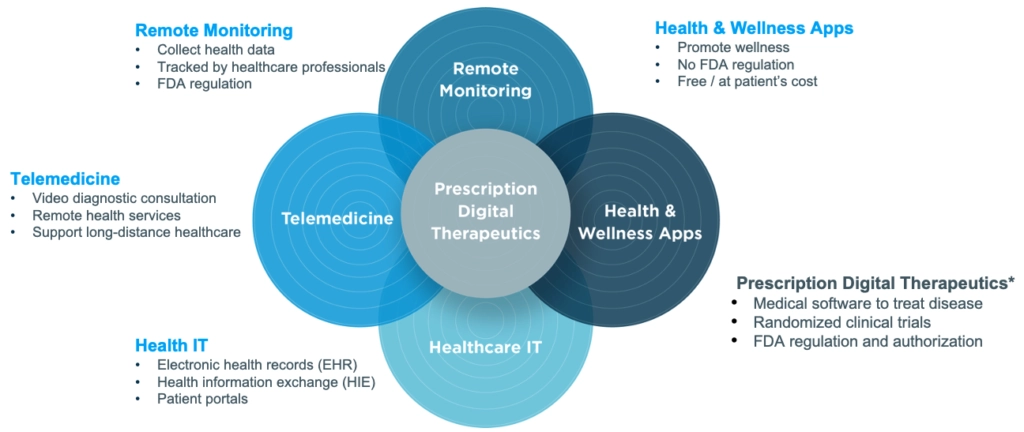Growing clinical validation for digital therapeutics
For companies offering digital therapeutics, much of the past decade has been focused on developing their offerings and then testing to ensure they are clinically valid. "Five years ago, digital therapeutics were still being tested and validated," said Eddie Martucci, co-founder and CEO of prescription digital medicine company Akili Interactive, in an email. "People had questions about the efficacy of DTx [digital therapeutics], and for many, digital therapeutics felt like science fiction. We've pushed hard for clinical validation in this industry, and in the last five years we've seen a significant amount of clinical validation for DTx, including compelling real-world data showing how these new approaches can help improve patients' lives." For example, Akili Interactive offers technologies designed to strengthen the brain's cognitive function. Its proprietary prescription video game treatment, EndeavorRx, which has been cleared by the Food and Drug Administration, aims to improve attention function in children with attention-deficit/hyperactivity disorder. The platform deploys sensory stimuli and simultaneous motor challenges designed to target and activate specific networks in the brain that are key to certain cognitive functioning, Martucci explained. But to get that all-important FDA clearance, Akili had to first prove its device's efficacy. In the last five years, the company has published data from five different clinical studies, including a prospective, randomized, controlled study published in The Lancet Digital Health. The Lancet study showed that roughly half of the parents whose children used the Akili device saw a clinically meaningful change in their child’s day-to-day impairments. Similarly, Kaia Health, a digital therapeutics company focused on pain relief, has been conducting studies and clinical trials to evaluate its solutions. Its offerings include a treatment for musculoskeletal (MSK) pain and one for chronic obstructive pulmonary disease, though the latter has not been introduced in the US as yet."In the simplest terms, Kaia is in business to enable people to lead lives that are more pain-free and enable them to enjoy things that previously they were unable to do," said Nigel Ohrenstein, president of Kaia Health in a phone interview.
Kaia's MSK solution leverages mobile technology that provides MSK pain patients with physical therapy modules that lead patients through exercises. The solution also uses artificial intelligence to gauge exercise performance and adjust exercises based on how easily patients are able to perform them. Kaia has published studies showing the safety of its solution. Recently, a study published in JMIR Human Factors revealed that fewer than 1 percent of Kaia MSK solution users reported any adverse events. Kaia is also working to show that its solution can help cut healthcare costs. A randomized controlled trial focused on the digital MSK industry shows that medical claims costs for patients using the Kaia Health solution as part of a low back pain therapy program were 80 percent lower as compared with claims costs of those receiving standard therapy. According to Ohrenstein, digital therapeutics have the potential to transform healthcare. "Science has evolved significantly in the medical field over time and has enabled people to live longer lives, healthier lives, better lives than they previously could," Ohrenstein said. "Digital therapeutics is just another frontier in that evolution." Corey McCann, president and CEO of Pear Therapeutics, echoed this sentiment. "We really see a future where most medical conditions are treated with pieces of software," he said in a phone interview. Pear provides prescription digital therapeutics (PDT), that is, software designed to treat medical conditions under a clinician's supervision. Its offerings include reSET and reSET-O, which are used to treat substance and opiate use disorders. "reSET and reSET-O are 12-week prescriptions," McCann said. "During those 12 weeks, you'll engage with the product for about one-to-two hours per week. And during that experience, you walk through what are didactic lessons — they're audio, they're video, and they are written text." The didactic lessons leverage a very specific type of cognitive behavioral therapy called the community reinforcement approach, which helps addiction patients rewire their brains to enable them to abstain from substance abuse, he added. Both reSET and reSET-O have been authorized by the FDA as the first prescription digital therapeutics for substance abuse disorders and opioid use disorders, respectively. This clinical validation has led to the products being covered by health plans and implemented in treatment centers. "I think you saw initially a demonstration in randomized clinical trials that ultimately software could create drug-like outcomes," McCann said. " I think now what you're seeing is…an acknowledgment of really the critical nature of a regulatory path. And right now, we're in the implementation phase."
What's to come
The digital therapeutics industry experienced a major boost in 2020 when the COVID-19 pandemic hit. "COVID-19 shone a light on the need for innovative treatment options that can be used at home from your phone or tablet, helping to propel the DTx industry to the forefront of medicine," Akili Interactive's Martucci said. "Consumer expectations of healthcare have also continued to grow, with patients looking for increased control, flexibility, and seamless integration into their lives." This sets up a year full of growth potential for digital therapeutics in 2022. Martucci believes that we will see the development of new digital therapeutics that address a wider range of physiological conditions in 2022. And Kaia Health's Ohrenstein agrees. "We'll continue to see more disease states that have digital therapies that are effective," he said. Further, as adoption grows among providers, payers, and employers, digital therapeutics will likely become step therapies, that is, therapies prescribed to patients before a more invasive treatment is required, Ohrenstein said. "To my mind, when we roll the clock forward five years and beyond, we're going to see a healthcare system that not only has widely adopted digital therapies but a population that looks to them first rather than racing to drugs or operations or other areas that have proven time and time again to not only be high cost but ultimately not as, in the long term, in the best interest of individual patients," he added. But first, reimbursement for digital therapies needs to be solidified. At the end of 2021, the American Medical Association's (AMA) Current Procedural Terminology (CPT) Editorial Panel clarified the CPT codes — a uniform language for coding medical services on which billing is based — for cognitive behavioral therapy monitoring services. The clarification enables providers to code for digital therapeutics delivered as part of cognitive behavioral therapy services. "I think you'll see a continued drumbeat of coverage decisions and utilization for commercial [digital therapy] products," Pear Therapeutics' McCann said. In addition, like Ohrenstein and Martucci, McCann believes that in 2022 we will see regulatory approval for new digital therapy products addressing conditions like epilepsy, multiple sclerosis, and stroke. "I think by the tail end of the five years, you'll see PDTs for most conditions," he said. "And if you look at the individual PDTs, you'll see them employing things like virtual reality, like different artificial intelligence-based algorithms."How digital therapeutics companies plan to prepare
Akili Interactive is already looking ahead to expanding its technology to new disease states. "With the success of our first FDA-cleared product, we are applying that core technology to a number of other chronic and acute conditions like autism, multiple sclerosis, depression, COVID 'brain fog' and more," Martucci said. The company recently announced plans to go public via a merger with a special purpose acquisition company. Meanwhile, Pear Therapeutics is focused on building out its current pipeline to meet mental health and addiction recovery needs. Its reSET-A PDT product, designed for the treatment of alcohol use disorder, received FDA Breakthrough Device Designation last year. The company also recently brought in a new set of assets for major depressive disorder, McCann said. "What we are aiming to do is initially be the one-stop shop for all things related to mental and behavioral health," he added. "That's the initial focus of our pipeline." Kaia Health, on the other hand, plans to double down on validation efforts through clinical research, Ohrenstein said. As clinical evidence and regulatory approvals continue to spur digital therapeutics use, it is likely that this new category of medicine will become a key part of traditional care delivery. "When the history's written on this evolution of healthcare, digital therapeutics will be a major part of that evolution," Ohrenstein said.Source: How Digital Therapeutics Will Evolve in 2022 and Beyond (mhealthintelligence.com)


